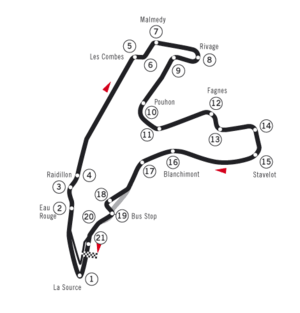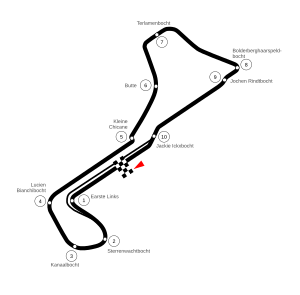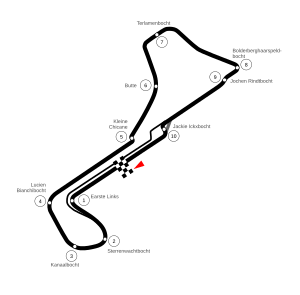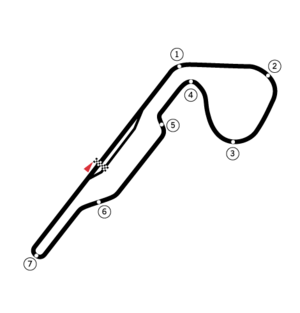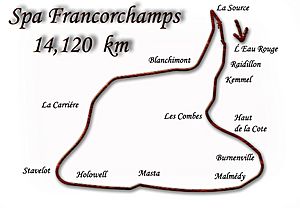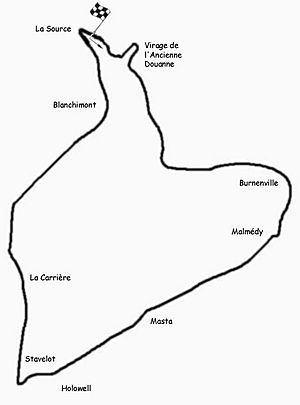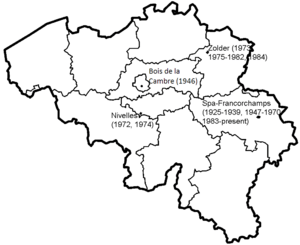Belgian Grand Prix facts for kids
| Circuit de Spa-Francorchamps (intermittently; 1925–1939, 1947–1970, 1983–present) |
|
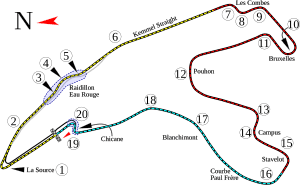 |
|
| Race information | |
|---|---|
| Number of times held | 80 |
| First held | 1925 |
| Most wins (drivers) | |
| Most wins (constructors) | |
| Circuit length | 7.004 km (4.352 mi) |
| Race length | 308.052 km (191.398 mi) |
| Laps | 44 |
| Last race (2024) | |
| Pole position | |
|
|
| Podium | |
|
|
| Fastest lap | |
|
|
The Belgian Grand Prix is a famous Formula One car race. It's known by different names in other languages, like Grand Prix de Belgique in French.
The very first race in Belgium happened in 1925. It took place in the Spa area, which has a long history with motor sports. The Circuit de Spa-Francorchamps race track was built in 1921. At first, it was only used for motorcycle races. After a successful 24-hour race in France in 1923, a similar endurance race called the Spa 24 Hours was also held at the Spa track.
The Spa-Francorchamps track is famous for its unpredictable weather. It has often rained during the Belgian Grand Prix. Drivers might even find one part of the track dry and sunny, while another part is wet and slippery! This makes the race very exciting and challenging. It's one of the most popular races for both drivers and fans because of its beautiful and historic circuit.
Contents
A Look Back: History of the Race
Early Days at Spa-Francorchamps
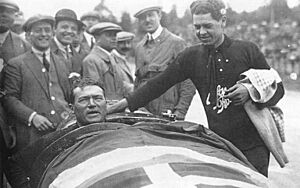
The first Belgian Grand Prix in 1925 was held at the very fast Spa-Francorchamps circuit. This track is in the Ardennes region of eastern Belgium. Italian driver Antonio Ascari won this first race. Sadly, he tragically died in his very next race. His son, Alberto Ascari, would later win the Belgian Grand Prix in 1952 and 1953.
The race didn't return until 1930. The track was changed a bit, and Louis Chiron won. In 1931, the race became more of an endurance event. In 1935, Rudolf Caracciola won in a Mercedes.
The 1939 race saw the creation of the famous Raidillon corner. This part of the track is very tricky. The small left turn at the bottom is called Eau Rouge, which leads into the long uphill right turn of Raidillon. The conditions were very bad that year. British driver Richard Seaman had a serious accident in the rain. His car caught fire, and he was badly injured, sadly passing away later in the hospital. His teammate, Hermann Lang, won the race. World War II then stopped the race for several years. It returned in June 1946 at a public park in Brussels called Bois de la Cambre.
The Old Spa-Francorchamps Track
After the war, the Spa track was made even faster. It became known as one of the most extreme and challenging circuits in motor racing history. In 1950, the Formula One World Championship began. Juan Manuel Fangio won the first F1 Belgian Grand Prix.
The 1957 race was cancelled because there wasn't enough money. In 1958, Spa got some upgrades. But it was still known as a very tough and unforgiving track. Drivers had to be extremely precise because there was little room for error. The weather was also very unpredictable. One part of the track could be dry, while another was soaking wet. Drivers didn't have radios back then, so they couldn't be warned about rain ahead. Many drivers were seriously injured or died at Spa during the 1950s.
The 1960 race weekend was one of the most difficult in Formula One history. New, lighter cars were being used, which were faster. But these cars and the track had almost no safety features. During practice, Stirling Moss crashed heavily and suffered serious injuries, including broken bones. Another driver, Mike Taylor, also crashed and suffered severe injuries that ended his racing career.
The race itself was even more tragic. On lap 17, British driver Chris Bristow crashed and tragically died instantly. Just five laps later, Alan Stacey also had a terrible accident and died. Australian Jack Brabham won the race. Future racing legend Jim Clark scored his first F1 points. However, many drivers, including Clark, developed a strong dislike for the circuit after these events. It was the worst Formula One race in terms of fatalities until the 1994 San Marino Grand Prix.
In 1961, Ferrari cars were very strong, winning the top four spots. Jim Clark won his first race in 1962 and went on to win the next three Belgian Grands Prix as well. The 1963 race was very wet, with Clark winning by a huge margin. In 1966, cars had more powerful engines. Another rain-soaked race saw many accidents. British driver Jackie Stewart had a very high-speed crash. His car landed upside down, and he was trapped inside for nearly 30 minutes. This crash inspired Stewart to become a strong advocate for safety in motor racing.
In 1967, American Dan Gurney won. In 1968, wings were used on F1 cars for the first time to help with aerodynamics. Bruce McLaren won his team's first-ever victory. But another serious accident occurred when Brian Redman crashed and was badly burned and injured.
By 1969, safety concerns at Spa became a major issue. The cars were going over 240 km/h (150 mph), but the track still had almost no safety barriers. Drivers were becoming less and less happy with the circuit. The Grand Prix Drivers' Association demanded safety improvements. When the track owners didn't want to pay, many teams refused to race, and the event was cancelled. One last race was held there in 1970 with some temporary safety changes, but the track was still considered too fast and dangerous. The Belgian Grand Prix was cancelled in 1971 and moved to other locations.
New Tracks: Zolder and Nivelles
After Spa was deemed too dangerous, Belgium decided to hold its Grand Prix at two different tracks: Zolder in northern Belgium and Nivelles-Baulers near Brussels. The first race at Nivelles in 1972 was won by Emerson Fittipaldi. Zolder hosted the race in 1973, won by Jackie Stewart. Nivelles hosted again in 1974, but it wasn't very popular, and the track soon stopped hosting F1 races.
Zolder hosted the Belgian Grand Prix nine more times. Famous drivers like Niki Lauda, Gunnar Nilsson, Mario Andretti, Jody Scheckter, and Didier Pironi all won races there.
The 1981 race at Zolder was very chaotic. There were problems with the track's narrow pitlane. During practice, a mechanic was accidentally run over and sadly died the next day. On race day, there was a drivers' strike due to the poor conditions. The race started late, and then another mechanic was hit on the starting grid. The race was eventually restarted and won by Carlos Reutemann.
In 1982, Canadian driver Gilles Villeneuve tragically died during practice at Zolder after a collision. John Watson won that race.
Back to Spa-Francorchamps
The Spa-Francorchamps track was shortened and redesigned in 1979 to make it safer. The new 7 km (4.3 mi) layout was an instant hit with drivers and fans. The first race on the new Spa circuit was won by Alain Prost.
The Belgian Grand Prix returned to Zolder one last time in 1984, with Michele Alboreto winning. After that, the race has been held at the improved Spa-Francorchamps circuit.
In 1985, the race was postponed because new asphalt on the track broke up in the hot weather. When it was finally held in September, Ayrton Senna won his first of five Belgian Grands Prix. Senna went on to win four Belgian Grands Prix in a row from 1988 to 1991.
In 1992, Michael Schumacher won his very first Grand Prix victory at Spa. He would go on to win 91 races in his career! Damon Hill won in 1993 after a great battle.
In 1994, a temporary chicane (a series of tight turns) was added at Eau Rouge for safety reasons. This was after the tragic deaths of Ayrton Senna and Roland Ratzenberger at another race earlier that year. The chicane was removed in 1995, and Schumacher won that race and the next two. The 1998 race was held in terrible rain. It was stopped after a huge crash at the first corner involving many cars. After a restart, Michael Schumacher crashed into David Coulthard, leading to a heated argument. Only eight drivers finished the race, and Damon Hill won, giving the Jordan team their first F1 victory.
Michael Schumacher won his 52nd Grand Prix at Spa in 2001, breaking Alain Prost's record. Schumacher also won his seventh World Drivers' Championship title at Spa in 2004. The Belgian Grand Prix was not held in 2003 due to Belgium's tobacco advertising laws. It was also not on the calendar in 2006 because of track repairs. The race returned in 2007, with Kimi Räikkönen winning his third Belgian Grand Prix in a row.
In 2008, Lewis Hamilton won a very exciting race in the rain. However, he received a penalty after the race for cutting a corner, which dropped him to third place. This decision caused a lot of debate.
The 2021 race was very unusual. It became the shortest Formula One World Championship race ever. Only two laps were completed behind the safety car due to very bad weather before the race was stopped. Half points were awarded, which led to changes in how points are given for shortened races in the future. The 2022 race was won by Max Verstappen from 14th place, which is a very impressive achievement. The race's contract has been extended, and it is planned to be held in 2026, 2027, 2029, and 2031.
Race Winners
Drivers with Multiple Wins
Drivers in bold are currently competing in Formula One.
Michael Schumacher has won the Belgian Grand Prix six times, more than any other driver. Ayrton Senna and Lewis Hamilton have each won five times. Kimi Räikkönen and Jim Clark both have four wins.
| Wins | Driver | Years won |
|---|---|---|
| 6 | 1992, 1995, 1996, 1997, 2001, 2002 | |
| 5 | 1985, 1988, 1989, 1990, 1991 | |
| 2010, 2015, 2017, 2020, 2024 | ||
| 4 | 1962, 1963, 1964, 1965 | |
| 2004, 2005, 2007, 2009 | ||
| 3 | 1950, 1954, 1955 | |
| 1993, 1994, 1998 | ||
| 2011, 2013, 2018 | ||
| 2021, 2022, 2023 | ||
| 2 | 1952, 1953 | |
| 1972, 1974 | ||
| 1975, 1976 | ||
| 1983, 1987 | ||
| Source: | ||
Teams with Multiple Wins
Teams in bold are currently competing in Formula One. A pink background means the race was not part of the Formula One World Championship. A yellow background means the race was part of the pre-war European Championship.
| Wins | Constructor | Years won |
|---|---|---|
| 18 | 1952, 1953, 1956, 1961, 1966, 1975, 1976, 1979, 1984, 1996, 1997, 2001, 2002, 2007, 2008, 2009, 2018, 2019 | |
| 14 | 1968, 1974, 1982, 1987, 1988, 1989, 1990, 1991, 1999, 2000, 2004, 2005, 2010, 2012 | |
| 8 | 1962, 1963, 1964, 1965, 1972, 1977, 1978, 1985 | |
| 1935, 1939, 1955, 2015, 2016, 2017, 2020, 2024 | ||
| 6 | 2011, 2013, 2014, 2021, 2022, 2023 | |
| 4 | 1925, 1947, 1950, 1951 | |
| 1981, 1986, 1993, 1994 | ||
| 3 | 1930, 1931, 1934 | |
| 2 | 1933, 1954 | |
| 1992, 1995 | ||
| Sources: | ||
Engine Manufacturers with Multiple Wins
Manufacturers in bold are currently competing in Formula One. A pink background means the race was not part of the Formula One World Championship. A yellow background means the race was part of the pre-war European Championship.
| Wins | Manufacturer | Years won |
|---|---|---|
| 18 | 1952, 1953, 1956, 1961, 1966, 1975, 1976, 1979, 1984, 1996, 1997, 2001, 2002, 2007, 2008, 2009, 2018, 2019 | |
| 14 | 1935, 1939, 1955, 1999, 2000, 2004, 2005, 2010, 2012, 2015, 2016, 2017, 2020, 2024 | |
| 10 | 1968, 1972, 1973, 1974, 1977, 1978, 1980, 1981, 1982, 1992 | |
| 8 | 1983, 1985, 1993, 1994, 1995, 2011, 2013, 2014 | |
| 6 | 1986, 1988, 1989, 1990, 1991, 2021 | |
| 5 | 1960, 1962, 1963, 1964, 1965 | |
| 4 | 1925, 1947, 1950, 1951 | |
| 3 | 1930, 1931, 1934 | |
| 2 | 1933, 1954 | |
| Sources: | ||
* Built by Cosworth, funded by Ford
** Between 1999 and 2005 built by Ilmor, funded by Mercedes
Winners by Year
A pink background means the race was not part of the Formula One World Championship. A yellow background means the race was part of the pre-war European Championship. A green background means the race was part of the pre-war World Manufacturers' Championship.
See also
 In Spanish: Gran Premio de Bélgica para niños
In Spanish: Gran Premio de Bélgica para niños


